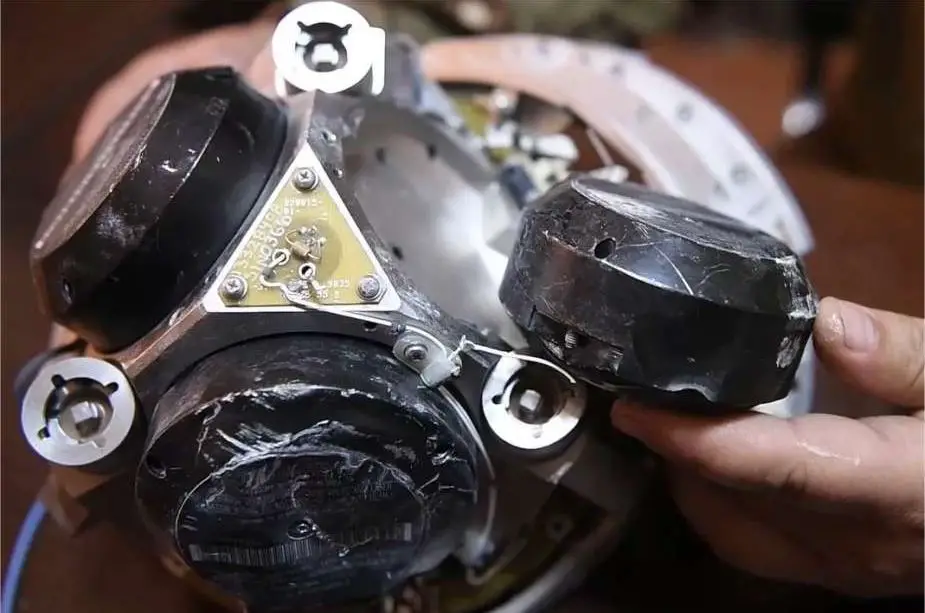Breaking News
Russia Gains Access to American ATACMS Missile Technology Through Debris Recovery in Ukraine.
Recently, the Russian Ministry of Defense announced that its forces have recovered debris from an American ATACMS missile. This recovery aims to aid Russian engineers in studying the missile's design to develop effective countermeasures. The Russian news outlet Sputnik provided detailed insights into the examination and analysis of the ATACMS missile's components, particularly focusing on its M74 cluster submunitions.
Follow Army Recognition on Google News at this link

Russian engineers study American ATACMS missile technology thanks to debris recovered in Ukraine. (Picture source: Russia MoD)
The ATACMS (Army Tactical Missile System) is a surface-to-surface missile developed by the United States, designed to deliver precision strikes at long ranges. It is a tactical ballistic missile system with a range of up to 300 kilometers, providing the U.S. Army with deep-strike capabilities. The ATACMS uses an advanced guidance system that incorporates GPS and inertial navigation to ensure high accuracy in hitting designated targets. This precision allows it to effectively engage and destroy high-value targets such as enemy command centers, air defense systems, and logistics hubs, making it a crucial asset in modern warfare.
The ATACMS missile can be equipped with various types of warheads to suit different mission requirements. The primary types include unitary warheads and cluster munitions. The unitary warhead is designed for precision strikes, delivering a high-explosive payload to a single target point. In contrast, the cluster munition warhead consists of M74 cluster munitions, which disperse multiple smaller submunitions over a wide area. This makes the ATACMS effective against dispersed or area targets such as enemy troops, vehicles, and equipment. This versatility in warhead types enhances the ATACMS's utility in a wide range of combat scenarios, providing flexibility and effectiveness in achieving mission objectives.
The M74 cluster munition, used within the ATACMS missile's cluster munition warhead, is designed to maximize damage over a broad area. Each M74 submunition is a green, spherical object about the size of a tennis ball, equipped with protrusions that induce spin upon release. This spinning activates centrifugal stoppers, arming the submunition for detonation upon impact. Containing a tungsten alloy casing, the M74 generates high-velocity fragments that can penetrate targets up to 50 meters away. With up to 275 submunitions dispersed from one missile, the M74 effectively neutralizes dispersed targets such as enemy troops and light vehicles, providing both precision and wide-area impact.
The analysis conducted by Russian military experts reveals the intricate design and operational mechanics of the M74 cluster submunitions within the ATACMS missile. Each ATACMS missile contains 275 of these submunitions, which are designed to disperse approximately 200 meters above the ground. The submunitions are green, spherical objects similar in size to a tennis ball, featuring protrusions that induce rotation during descent. This rotation activates centrifugal stoppers, allowing the internal engine to engage and position the primer/detonator opposite the striker, leading to detonation upon impact.
A critical aspect highlighted by the specialists is the sensitivity and danger posed by unexploded submunitions. These devices, if they fail to detonate on impact, remain highly volatile. The striker remains cocked, making any movement potentially lethal. Civilians encountering such devices are advised to exercise extreme caution.
The M74 submunitions are constructed using a stamped outer coating and an inner casing made of tungsten alloy, known for its durability and ability to increase fragment speed upon explosion. This design is compared to the RGO hand grenade, although with tungsten instead of steel. The tungsten casing contributes to the submunition's lethality by enhancing the fragmentation effect, resulting in a higher velocity and penetration capability of the fragments.
The effective fragmentation radius of these submunitions is around 20 meters, but some fragments can remain dangerous up to 50 meters, capable of penetrating metal doors. The coverage area of a single missile's submunitions is substantial, with fragments potentially affecting a 400 by 400 meter area, posing a significant risk to both military personnel and civilians.
The recovery and detailed study of the ATACMS missile debris underscore a strategic effort by Russia to enhance its defensive and counter-offensive capabilities. By understanding the intricate mechanics and vulnerabilities of the ATACMS submunitions, Russian military engineers can potentially develop countermeasures to mitigate the missile's effectiveness. This analysis might also influence Russia's own missile development programs, integrating learned features and avoiding identified weaknesses.
The Russian Ministry of Defense's recovery and examination of the ATACMS missile debris represents a significant step in the ongoing technological arms race between global powers. The detailed insights provided by Sputnik highlight the sophisticated nature of modern missile technology and the continuous efforts to counteract it. As the analysis progresses, it will be crucial to monitor how this newfound knowledge influences military strategies and the development of advanced countermeasures.


























